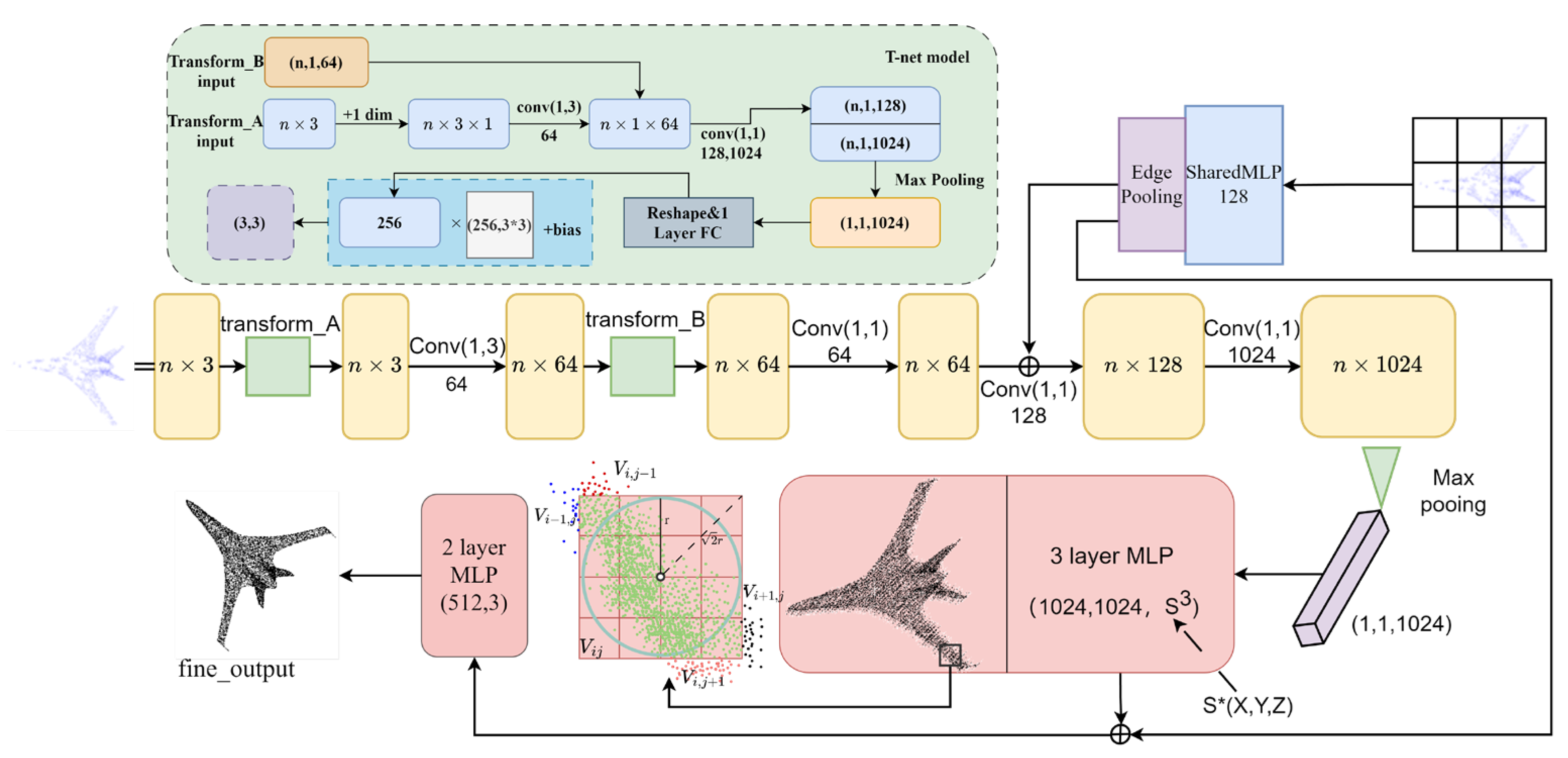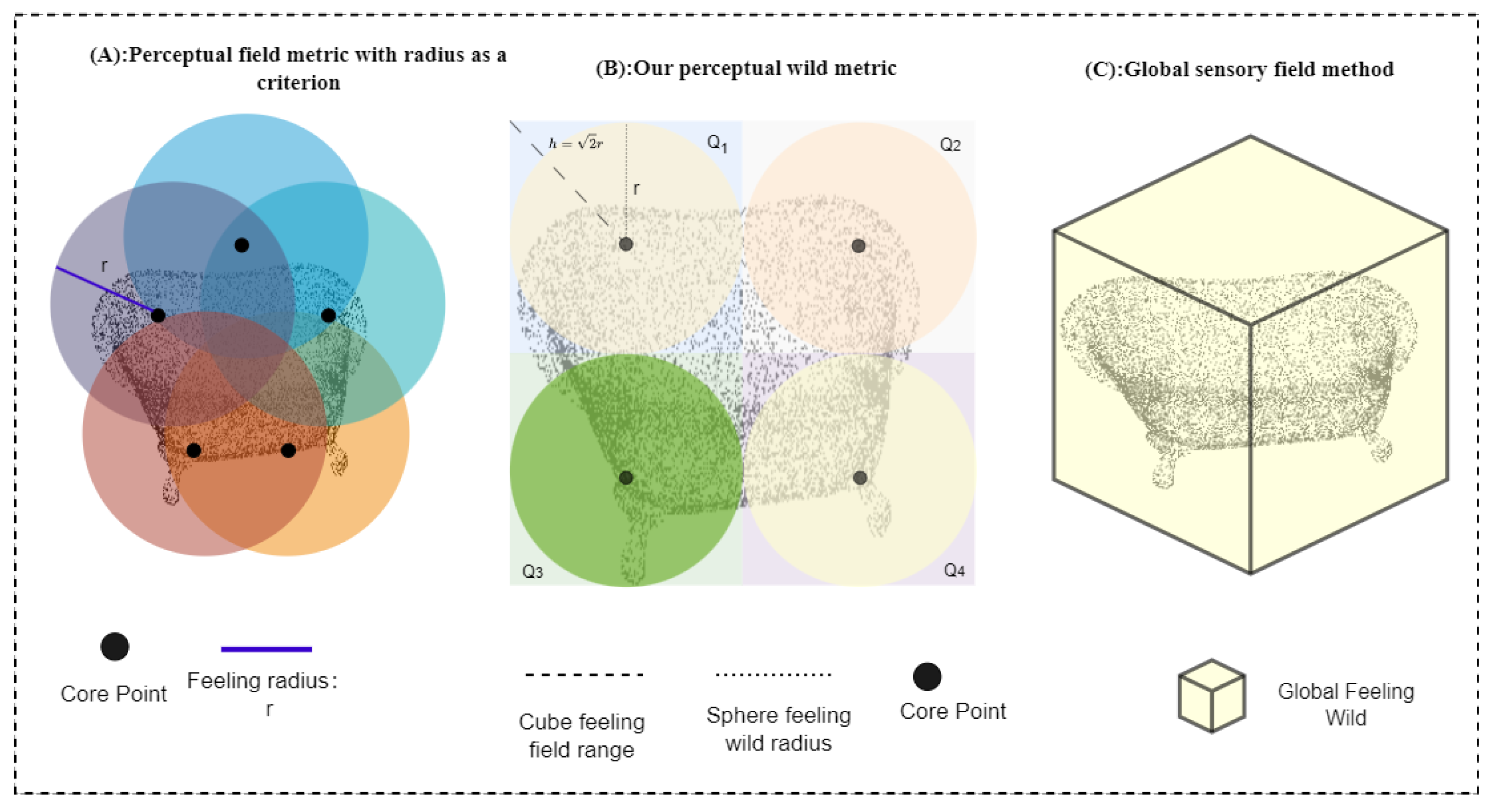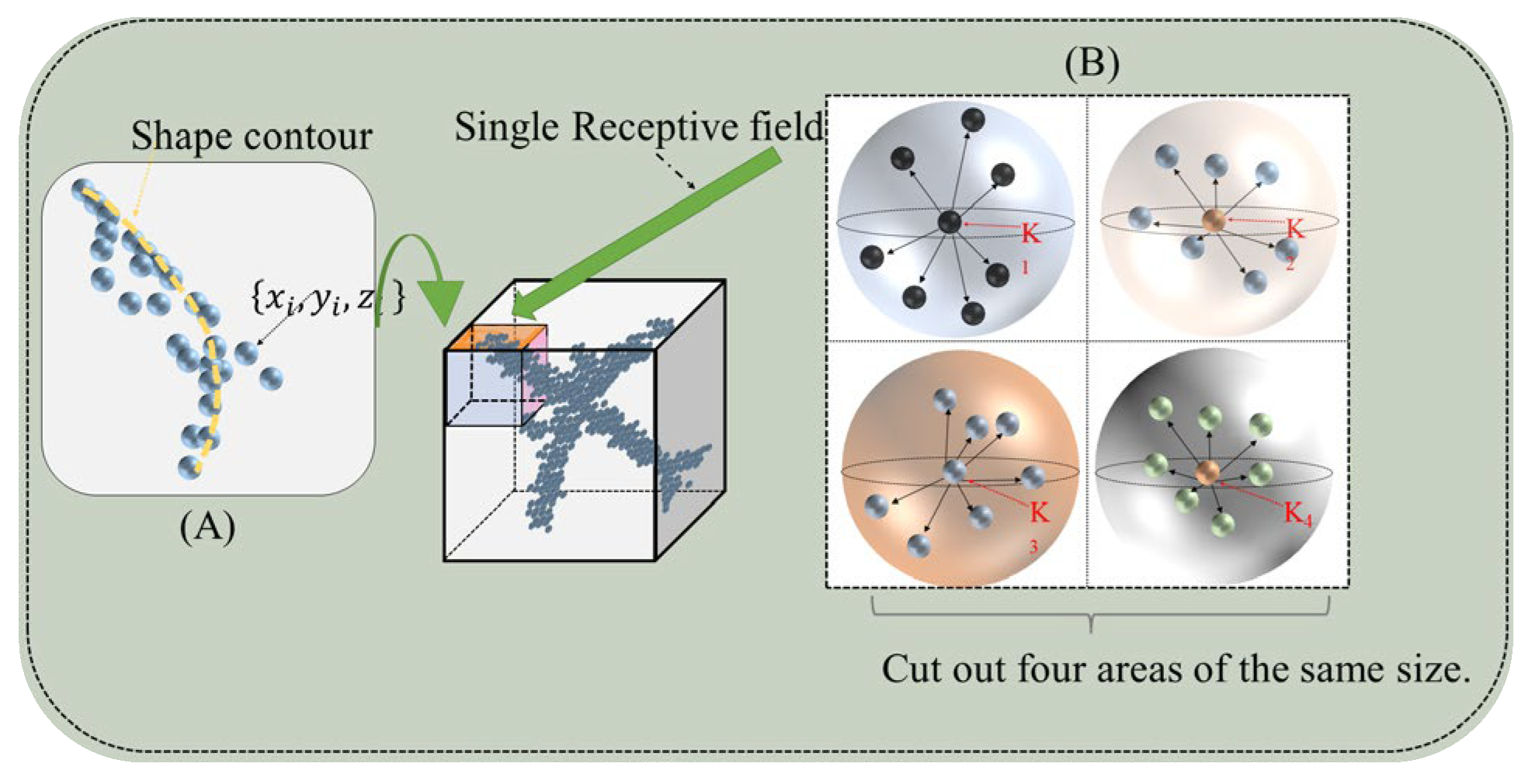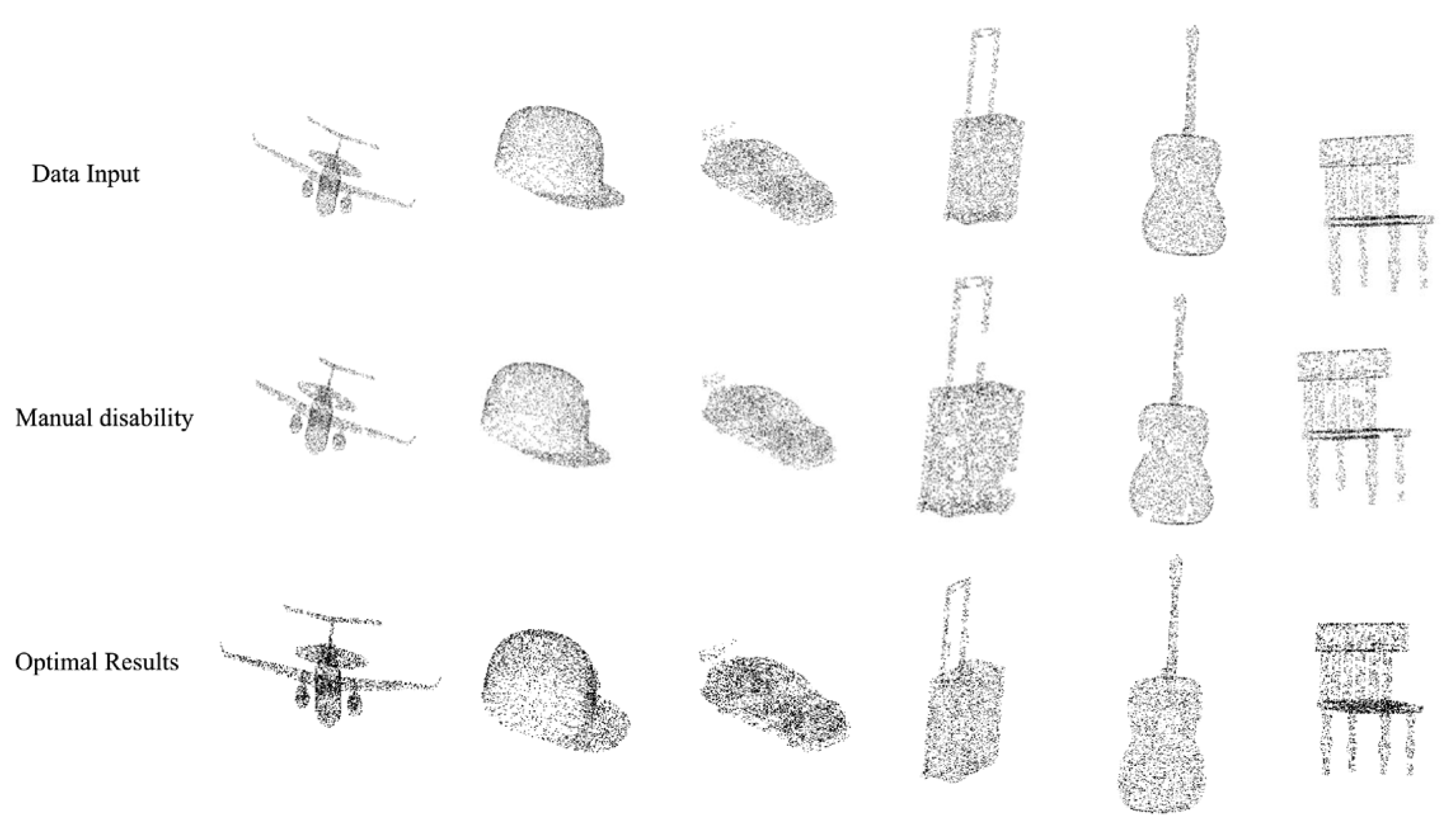Partition-Based Point Cloud Completion Network with Density Refinement
Abstract
1. Introduction
- (1)
- Proposed an encoder-decoder architecture that models pairwise interactions between point cloud elements to infer missing elements for point cloud completion.
- (2)
- Introduced a spatially sliced sensory field that transforms the input point cloud into uniform perceptual fields for better local feature representation in the transformer model.
- (3)
- Developed a geometric density-aware block to improve the exploitation of the 3D geometric structure and preserve fine details in the point cloud.
2. Related Work
2.1. Point Cloud Convolution
2.2. Point Cloud Completion
3. Method
3.1. Regional Experience Field
3.2. Global and Sub-Regional Convolution
3.3. Sub-Regional Optimization
4. Experiments and Evaluations
4.1. Loss Function
4.2. Implementation Details
4.3. Optimization
- (1)
- First, we need to estimate the local density of each point , i.e., the number of points in its -neighborhood. We can use either the k-nearest neighbor algorithm or the mesh partitioning algorithm to achieve this step.
- (2)
- Then, we can determine which points are outliers or noise points based on the density threshold and remove them. This step can be represented by the following equation: . where is the probability that belongs to an outlier, is a classification function, and is the set of points in the -neighborhood of . We define uniformly dispersed core points in the tangent region, with the distance between and defined as , we need to estimate the local density of each core point and find the farthest distance points with the distance limit ( is determined empirically).
- (3)
- The farthest points from the cores of the cat-off region are defined as “potentially discrete points”. The region represented by each is sampled or filtered to reduce the amount of data and preserve the main features. We can use uniform sampling, nearest neighbor interpolation, bilateral filtering, etc. to achieve this step. This step can be represented by the following equation: , where is the offset estimated for the point (or zero if there is no offset), and is a denoising or refinement function that is the other points in the cluster to which belongs.
- (4)
- The final denoised and refined point cloud is obtained as: , where is the final prediction for point . The comparison results of the point cloud detail optimization after our design are shown in Table 4. The CD-D(CD With Density) and EMD-D(EMD With Density) are representations of the results after the optimization of our model combining density and spatial location.
4.4. Results
5. Conclusions and Discussions
- (1)
- Local-Global Fusion: We introduce the concept of perceptual fields, which divide the input point cloud into uniform local regions. By combining global and local information, our method effectively captures the overall shape and fine-grained details, preserving sharp edges and detailed structures.
- (2)
- Transformer-based Model: We utilize a transformer model to process the feature vectors obtained from each perceptual field. This allows us to capture long-range dependencies and effectively infer missing elements in the point cloud.
- (3)
- Geometric Density-aware Block: We design a geometric density-aware block to leverage the inherent 3D geometric structure of the point cloud. This block enhances the preservation of important geometric features and improves the accuracy of the completed point cloud.
- (1)
- Lack of scalability: Our proposed method may face scalability issues when dealing with large-scale point clouds, as it involves the partitioning of the point cloud.
- (2)
- Limited effectiveness for complex objects: While our method achieves state-of-the-art results on several benchmark datasets, it may have limited effectiveness for complex objects with more intricate shapes and details.
- (3)
- Limited generalizability: Our approach may have limited generalizability to point clouds from different domains or with different characteristics, as it was designed specifically for point cloud completion tasks.
Author Contributions
Funding
Institutional Review Board Statement
Data Availability Statement
Conflicts of Interest
References
- Fei, B.; Yang, W.; Chen, W.M.; Li, Z.; Li, Y.; Ma, T.; Hu, X.; Ma, L. Comprehensive review of deep learning-based 3D point cloud completion processing and analysis. IEEE Trans. Intell. Transport. Syst. 2022, 23, 22862–22883. [Google Scholar] [CrossRef]
- Qi, C.R.; Su, H.; Mo, K.; Guibas, L.J. Pointnet: Deep learning on point sets for 3d classification and segmentation. In Proceedings of the 2017 IEEE/CVF Conference on Computer Vision and Pattern Recognition (CVPR), Hangzhou, China, 7–9 August 2017; pp. 652–660. [Google Scholar]
- Qi, C.R.; Yi, L.; Su, H.; Guibas, L.J. Pointnet++: Deep hierarchical feature learning on point sets in a metric space. In Proceedings of the 2017 Conference on Neural Information Processing Systems (NeurIPS), Long Beach, CA, USA, 4–9 July 2017; pp. 652–660. [Google Scholar]
- Wang, Y.; Sun, Y.; Liu, Z.; Sarma, S.E. Dynamic graph cnn for learning on point clouds. ACM Trans. Graph. 2019, 38, 1–12. [Google Scholar] [CrossRef]
- Pistilli, F.; Fracastoro, G.; Valsesia, D.; Magli, E. Learning Robust Graph-Convolutional Representations for Point Cloud Denoising. IEEE J. Sel. Top. Signal Process. 2021, 15, 402–414. [Google Scholar] [CrossRef]
- Wu, W.; Qi, Z.; Fuxin, L. PointConv: Deep Convolutional Networks on 3D Point Clouds. In Proceedings of the 2019 IEEE/CVF Conference on Computer Vision and Pattern Recognition(CVPR), Seoul, Republic of Korea, 4–6 November 2019; pp. 9613–9622. [Google Scholar]
- Yuan, W.; Khot, T.; Held, D.; Mertz, C.; Hebert, M. PCN: Point Completion Network. In Proceedings of the 2018 International Conference on 3D Vision (3DV), Verona, Italy, 5–8 September 2018; pp. 728–737. [Google Scholar]
- Najibi, M.; Rastegari, M.; Davis, L.S. G-CNN: An Iterative Grid Based Object Detector. In Proceedings of the 2016 IEEE Conference on Computer Vision and Pattern Recognition (CVPR), Las Vegas, NV, USA, 27–30 June 2016; pp. 2369–2377. [Google Scholar]
- Wagh, N.; Varatharajah, Y. Eeg-gcnn: Augmenting electroencephalogram-based neurological disease diagnosis using a domain-guided graph convolutional neural network. In Proceedings of the Machine Learning for Health(PMLR), Virtually, 24 August 2020; pp. 367–378. [Google Scholar]
- Feng, F.; Huang, W.; He, X.; Xin, X.; Wang, Q.; Chua, T.S. Should graph convolution trust neighbors? a simple causal inference method. In Proceedings of the 44th International ACM SIGIR Conference on Research and Development in Information Retrieval (SIGIR), Virtually, 11–15 July 2021; pp. 1208–1218. [Google Scholar]
- Afrasiabi, S.; Mohammadi, M.; Afrasiabi, M.; Parang, B. Modulated Gabor filter based deep convolutional network for electrical motor bearing fault classification and diagnosis. IET Sci. Meas. Technol. 2021, 15, 154–162. [Google Scholar] [CrossRef]
- Dai, X.; Fu, R.; Zhao, E.; Zhang, Z.; Lin, Y.; Wang, F.Y.; Li, L. DeepTrend 2.0: A light-weighted multi-scale traffic prediction model using detrending. Transp. Res. Part C Emerg. Technol. 2019, 103, 142–157. [Google Scholar] [CrossRef]
- Shafqat, W.; Byun, Y.C. Incorporating similarity measures to optimize graph convolutional neural networks for product recommendation. Appl. Sci. 2021, 11, 1366. [Google Scholar] [CrossRef]
- Gu, J.; Wang, Z.; Kuen, J.; Ma, L.; Shahroudy, A.; Shuai, B.; Liu, T.; Wang, X.; Wang, G.; Cai, J.; et al. Recent advances in convolutional neural networks. Pattern Recognit. 2018, 77, 354–377. [Google Scholar] [CrossRef]
- Rana, M.A.; Mahmood, T.; Afzal, M. A Survey of Convolutional Neural Networks: Architectures, Algorithms, and Applications. IEEE Access 2021, 9, 129521–129549. [Google Scholar]
- Chiang, W.L.; Liu, X.; Si, S.; Li, Y.; Bengio, S.; Hsieh, C.J. Cluster-gcn: An efficient algorithm for training deep and large graph convolutional networks. In Proceedings of the 25th ACM SIGKDD International Conference on Knowledge Discovery & Data Mining, Anchorage, AK, USA, 4–8 August 2019; pp. 257–266. [Google Scholar]
- Zhao, L.; Song, Y.; Zhang, C.; Liu, Y.; Wang, P.; Lin, T.; Deng, M.; Li, H. T-gcn: A temporal graph convolutional network for traffic prediction. IEEE Trans. Intell. Transport. Syst. 2019, 21, 3848–3858. [Google Scholar] [CrossRef]
- Abu-El-Haija, S.; Kapoor, A.; Perozzi, B.; Lee, J. N-gcn: Multi-scale graph convolution for semi-supervised node classification. In Proceedings of the Uncertainty in Artificial Intelligence (PMLR), Online, 22–25 July 2019; pp. 841–851. [Google Scholar]
- Ben-Shabat, Y.; Lindenbaum, M.; Fischer, A. Nesti-net: Normal estimation for unstructured 3d point clouds using convolutional neural networks. In Proceedings of the 2019 IEEE/CVF Conference on Computer Vision and Pattern Recognition (CVPR), Seoul, Republic of Korea, 4–6 November 2019; pp. 10112–10120. [Google Scholar]
- Hermosilla, P.; Ritschel, T.; Ropinski, T. Total denoising: Unsupervised learning of 3D point cloud cleaning. In Proceedings of the 2019 IEEE/CVF Conference on Computer Vision and Pattern Recognition (CVPR), Seoul, Republic of Korea, 4–6 November 2019; pp. 52–60. [Google Scholar]
- Xie, H.; Yao, H.; Zhou, S.; Mao, J.; Zhang, S.; Sun, W. Grnet: Gridding residual network for dense point cloud completion. In Proceedings of the Computer Vision–ECCV 2020: 16th European Conference, Glasgow, UK, 23–28 August 2020; pp. 365–381. [Google Scholar]
- Zhang, Q.; Chen, Z.; Xue, Y.; Zhang, J. Attention-guided graph convolutional network for 3D point cloud classification. Signal Process. Image Commun. 2021, 99, 116317. [Google Scholar] [CrossRef]
- Wang, J.; Li, Y.; Sun, M.; Liu, Y.; Rosman, G. Learning to grasp objects with a robot hand-eye system using simulated depth images and point clouds. Sci. Robot. 2020, 5, 7695. [Google Scholar]
- Cao, S.; Zhao, H.; Liu, P. Semantic Segmentation for Point Clouds via Semantic-Based Local Aggregation and Multi-Scale Global Pyramid. Machines 2023, 11, 11. [Google Scholar] [CrossRef]
- Oh, H.; Ahn, S.; Kim, J.; Lee, S. Blind deep S3D image quality evaluation via local to global feature aggregation. IEEE Trans. Image Process. 2017, 26, 4923–4936. [Google Scholar] [CrossRef] [PubMed]
- Tchapmi, L.P.; Kosaraju, V.; Rezatofighi, H.; Reid, I.; Savarese, S. TopNet: Structural Point Cloud Decoder. In Proceedings of the 2019 IEEE/CVF Conference on Computer Vision and Pattern Recognition (CVPR), Seoul, Republic of Korea, 4–6 November 2019; pp. 383–392. [Google Scholar]
- Huang, W.; Xue, Y.; Hu, L.; Liuli, H. S-EEGNet: Electroencephalogram signal classification based on a separable convolution neural network with bilinear interpolation. IEEE Access 2020, 8, 131636–131646. [Google Scholar] [CrossRef]
- Gao, H.; Yuan, H.; Wang, Z.; Ji, S. Pixel transposed convolutional networks. IEEE Trans. Pattern Anal. Mach. Intell. 2019, 42, 1218–1227. [Google Scholar] [CrossRef] [PubMed]
- Dai, Y.; Lu, H.; Shen, C. Learning affinity-aware upsampling for deep image matting. In Proceedings of the IEEE/CVF Conference on Computer Vision and Pattern Recognition (CVPR), Virtual, 19–25 June 2021; pp. 6841–6850. [Google Scholar]
- Thomas, H.; Qi, C.R.; Deschaud, J.E.; Marcotegui, B.; Goulette, F.; Guibas, L.J. KPConv: Flexible and Deformable Convolution for Point Clouds. In Proceedings of the 2019 IEEE/CVF International Conference on Computer Vision (ICCV), Seoul, Republic of Korea, 27 October–3 November 2019; pp. 6410–6419. [Google Scholar]
- Wang, L.; Huang, Y.; Hou, Y.; Zhang, S.; Shan, J. Graph attention convolution for point cloud semantic segmentation. In Proceedings of the 2019 IEEE/CVF Conference on Computer Vision and Pattern Recognition (CVPR), Seoul, Republic of Korea, 4–6 November 2019; pp. 10296–10305. [Google Scholar]
- Komarichev, A.; Zhong, Z.; Hua, J. A-cnn: Annularly convolutional neural networks on point clouds. In Proceedings of the 2019 IEEE/CVF Conference on Computer Vision and Pattern Recognition (CVPR), Seoul, Republic of Korea, 4–6 November 2019; pp. 7421–7430. [Google Scholar]
- Ji, S.; Wang, Y.; Zhang, Y.; Liu, L.; Ye, Q. Squeeze-and-Excitation Networks for 3D Deep Shape Analysis of Human Organs. IEEE Trans. Med. Imaging 2020, 39, 1654–1664. [Google Scholar]
- Mousavirad, S.J.; Oliva, D.; Hinojosa, S.; Schaefer, G. Differential Evolution-based Neural Network Training Incorporating a Centroid-based Strategy and Dynamic Opposition-based Learning. In Proceedings of the 2021 IEEE Congress on Evolutionary Computation (CEC), Krakow, Poland, 28 June–1 July 2021; pp. 1233–1240. [Google Scholar]
- Roy, S.K.; Krishna, G.; Dubey, S.R.; Chaudhuri, B.B. HybridSN: Exploring 3-D–2-D CNN feature hierarchy for hyperspectral image classification. IEEE Geosci. Remote Sens. Lett. 2019, 17, 277–281. [Google Scholar] [CrossRef]
- Lin, C.J.; Jeng, S.Y.; Chen, M.K. Using 2D CNN with Taguchi parametric optimization for lung cancer recognition from CT images. Appl. Sci. 2020, 10, 2591. [Google Scholar] [CrossRef]
- Deng, D. DBSCAN Clustering Algorithm Based on Density. In Proceedings of the 2020 7th International Forum on Electrical Engineering and Automation (IFEEA), Guangzhou, China, 18–20 December 2020; pp. 949–953. [Google Scholar]
- Wen, Y.; Zhang, K.; Li, Z.; Qiao, Y. A discriminative feature learning approach for deep face recognition. In Proceedings of the 2016 European Conference on Computer Vision (ECCV), Amsterdam, The Netherlands, 8–16 October 2016; pp. 499–515. [Google Scholar]
- Fan, H.; Zhang, Y.; Hua, Z.; Li, J.; Sun, T.; Ren, M. ShapeNets: Image Representation Based on the Shape. In Proceedings of the 2016 IEEE 14th Intl Conf on Dependable, Autonomic and Secure Computing (DASC), Auckland, New Zealand, 8–12 August 2016; pp. 196–201. [Google Scholar]
- Borgefors, G. Hierarchical chamfer matching: A parametric edge matching algorithm. IEEE Trans. Pattern Anal. Mach. Intell. 1988, 10, 849–865. [Google Scholar] [CrossRef]
- Vahdat, A.; Williams, F.; Gojcic, Z.; Litany, O.; Fidler, S.; Kreis, K. LION: Latent Point Diffusion Models for 3D Shape Generation. In Proceedings of the 2022 Conference on Neural Information Processing Systems (NeurIPS), New Orleans, LA, USA, 28 November–9 December 2022; pp. 10021–10039. [Google Scholar]
- Lu, D.; Lu, X.; Sun, Y.; Wang, J. Deep feature-preserving normal estimation for point cloud filtering. Comput.-Aided Design 2020, 125, 102860. [Google Scholar] [CrossRef]
- Yan, X.; Zheng, C.; Li, Z.; Wang, S.; Cui, S. Pointasnl: Robust point clouds processing using nonlocal neural networks with adaptive sampling. In Proceedings of the 2020 IEEE/CVF Conference on Computer Vision and Pattern Recognition (CVPR), Washington, DC, USA, 14–19 June 2020; pp. 5589–5598. [Google Scholar]





| Method | Avg. | Airplane | Car | Chair | Guitar | Sofa |
|---|---|---|---|---|---|---|
| PCN | 13.17 | 11.74 | 13.56 | 14.58 | 12.79 | 13.2 |
| AtlasNet | 13.96 | 13.01 | 13.85 | 14.03 | 14.26 | 14.56 |
| TopNet | 11.184 | 10.4 | 11.5 | 13.08 | 10.93 | 10.55 |
| Our | 10.186 | 10.7 | 9.45 | 10.95 | 9.3 | 10.53 |
| Method | Avg. | Airplane | Car | Chair | Guitar | Sofa |
|---|---|---|---|---|---|---|
| PCN | 11.18 | 10.2 | 10.2 | 15.22 | 10.76 | 9.53 |
| AtlasNet | 12.097 | 11.16 | 10.3 | 15.1 | 10.43 | 13.4 |
| Our | 10.15 | 10.15 | 9.73 | 15.6 | 9.98 | 8.41 |
| Method | NOP*80% | NOP*50% | NOP*30% |
|---|---|---|---|
| PCN | 14.86 | 27.95 | null |
| AtlasNet | 15.09 | 29.56 | null |
| TopNet | 13.012 | 37.69 | null |
| Our | 12.007 | 28.82 | null |
| Method | CD | CD-D | CD-D 3000 | EMD | EMD-D | EMD-D 3000 |
|---|---|---|---|---|---|---|
| PCN | 13.174 | 12.174 | 11.174 | 11.18 | 10.25 | 10.25 |
| AtlasNet | 13.96 | 15.66 | 12.66 | 12.097 | 10.21 | 9.21 |
| TopNet | 11.184 | 9.98 | 9.98 | NULL | NULL | NULL |
| Our | 10.186 | 8.73 | 8.34 | 10.15 | 9.43 | 9.2 |
Disclaimer/Publisher’s Note: The statements, opinions and data contained in all publications are solely those of the individual author(s) and contributor(s) and not of MDPI and/or the editor(s). MDPI and/or the editor(s) disclaim responsibility for any injury to people or property resulting from any ideas, methods, instructions or products referred to in the content. |
© 2023 by the authors. Licensee MDPI, Basel, Switzerland. This article is an open access article distributed under the terms and conditions of the Creative Commons Attribution (CC BY) license (https://creativecommons.org/licenses/by/4.0/).
Share and Cite
Li, J.; Si, G.; Liang, X.; An, Z.; Tian, P.; Zhou, F. Partition-Based Point Cloud Completion Network with Density Refinement. Entropy 2023, 25, 1018. https://doi.org/10.3390/e25071018
Li J, Si G, Liang X, An Z, Tian P, Zhou F. Partition-Based Point Cloud Completion Network with Density Refinement. Entropy. 2023; 25(7):1018. https://doi.org/10.3390/e25071018
Chicago/Turabian StyleLi, Jianxin, Guannan Si, Xinyu Liang, Zhaoliang An, Pengxin Tian, and Fengyu Zhou. 2023. "Partition-Based Point Cloud Completion Network with Density Refinement" Entropy 25, no. 7: 1018. https://doi.org/10.3390/e25071018
APA StyleLi, J., Si, G., Liang, X., An, Z., Tian, P., & Zhou, F. (2023). Partition-Based Point Cloud Completion Network with Density Refinement. Entropy, 25(7), 1018. https://doi.org/10.3390/e25071018






